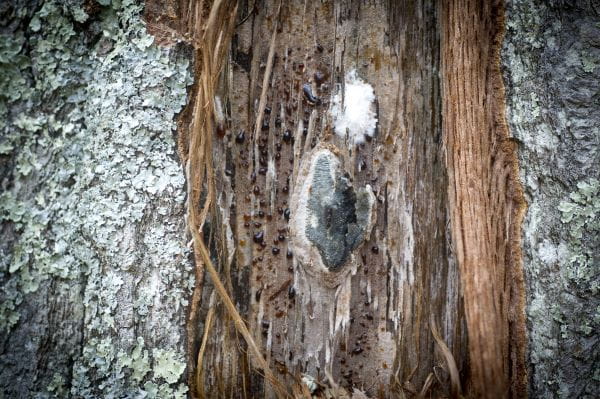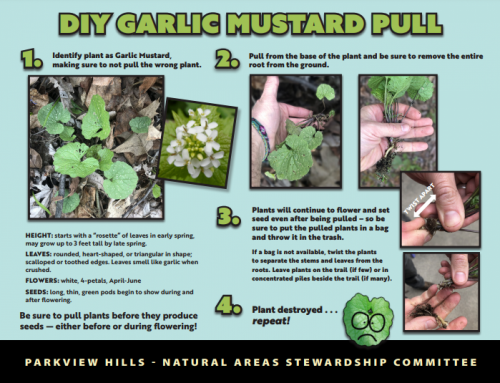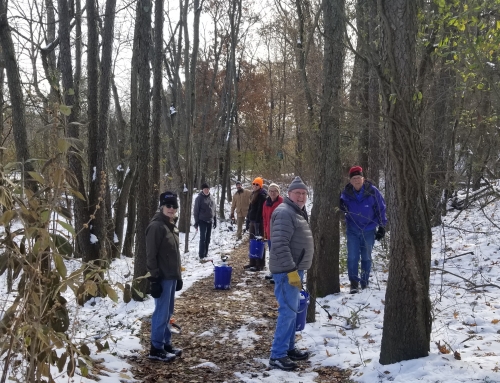Trees across Michigan are just wrapping up an incredible show of fall color, with the reds, oranges and yellows of oak trees often taking center stage. That annual autumn color fest may be at risk, though, because oak trees across areas of the Lower Peninsula, as well as in Dickinson, Iron, Marquette and Menominee counties in the Upper Peninsula, are dying from oak wilt.
One of the best ways to help prevent oak wilt from infecting trees on your property is to avoid wounding them during the high-risk infection period, April 15 to July 15. The safest time to prune oak trees is the winter season.
What is oak wilt?
Caused by the fungus Bretziella fagacearum, oak wilt is fatal to oak trees, especially those in the red oak family, which includes black oak, northern red oak and northern pin oak – all identifiable by their pointed leaf tips.
Once a tree is infected, the fungus may fruit, creating distinct gray to black fungal pads under the tree’s bark. Fungal spores can be picked up by sap-feeding nitidulid beetles attracted by the pads’ yeasty odor. Sap beetles spread oak wilt when they visit other pruned or damaged oaks to feed on their exposed sap.
Oak wilt often is first identified when green leaves turn yellow or brown on the edges and begin to drop during the summer.
Infected oaks can spread the disease to other oaks through underground root connections or grafts, creating an expanding circle of dead trees.
Avoid the high-risk period
April 15 through July 15 is considered the high-risk period for oak wilt spread because that is when nitidulid beetles are most active and more fresh spore mats are available. During this time, pruning or damaging oak trees should be avoided.
In a recent NotMISpecies webinar, “Getting Down to the Nitty Gritty: Oak Wilt Spread and Vector Behavior Research in Michigan,” Dr. Tara Bal and Katie Bershing of Michigan Technological University’s College of Forest Resources and Environmental Science shared ongoing research in Michigan’s Upper Peninsula and Canada indicating that sap beetles become interested in oak sap just after buds begin to open, a period called “leaf out,” and continue visiting wounded oaks through mid-summer. Further analysis is necessary to determine if this is true farther south.
“Winter is considered low risk, but we’re dealing with nature, and winter weather is sometimes warm,” said Bal. “Overland spread of oak wilt requires beetles to carry viable spores flying to fresh wounds at a time when trees are vulnerable. Research indicates this is unlikely to occur during winter months.”
“The designated dates for the oak wilt high-risk infection period consider variations in spring weather patterns, which can change the leaf-out date year to year and region by region within the state,” said Simeon Wright, forest health specialist with the Michigan Department of Natural Resources.
Landscaping and construction projects that can damage oaks also should avoid the high-risk period. When possible, choosing to postpone land clearing or use of heavy equipment around oak trees until the winter avoids a potential risk of infection that can persist into late summer.
Can other trees get oak wilt?
White oaks, those with rounded leaves, are susceptible to oak wilt but may survive for several years or succumb more slowly before dying.
Researchers from Michigan State University detected the oak wilt fungus in an orchard of dying Colossal chestnut trees in 2022, suggesting that chestnut trees, part of the same family as oaks (Fagaceae), also can be infected.
Where is oak wilt in Michigan?
The DNR maintains an interactive online map for viewing verified, reported and treated locations of oak wilt across the state. The tool also can be used to report suspected oak wilt infections.
What can be done?
If oak trees need pruning, trimming or removal, plan these activities for winter months when possible.
If construction or removal of other trees may damage nearby oaks, perform these activities outside of the high-risk period, April 15 to July 15.
If oaks are damaged during the high-risk period, immediately cover wounds with tree wound paint or a latex-based paint.
Don’t move firewood, especially if it comes from oak wilt-killed trees, as it can harbor and spread the fungus.
To learn more about oak wilt, visit Michigan.gov/ForestHealth or MichiganOakWilt.org.
Michigan’s Invasive Species Program is cooperatively implemented by the Michigan Departments of Agriculture and Rural Development; Environment, Great Lakes, and Energy; and Natural Resources. Please click here to visit the Invasive Species page, Michigan Invasive Species Program, for homeowners to learn more about invasives in Michigan
This article is republished with permission, and was originally published at https://www.michigan.gov/invasives/news/2024/11/13/prune-oaks-before-spring




